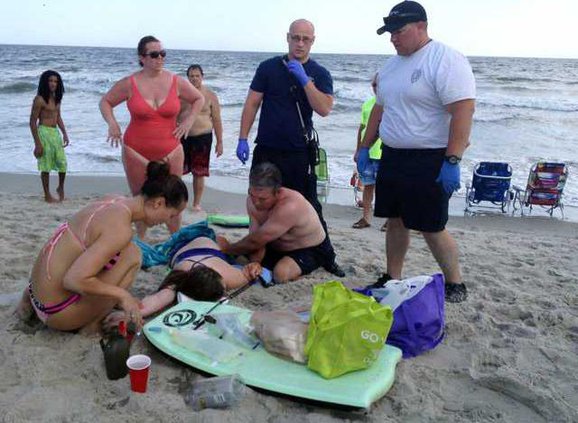Shark experts have a not-so-reassuring explanation for a recent spate of attacks along on the coast of the Carolinas: It's mainly because so many people are getting in the water.
Six shark attacks were recorded in June in North Carolina waters, and the two most recent victims had to be flown to a hospital in Virginia for treatment. That's more than North Carolina has recorded in any single year dating to 2000. But it's all a matter of perspective, said George Burgess, director of the Florida Program for Shark Research.
There were 28 attacks reported in Florida in 2014. So far this year, there have been 11 shark attacks there, with eight of those in neighboring Brevard and Volusia counties. Volusia is home to Daytona Beach, which is often packed with tourists.
"Obviously that's a much smaller area than the area of North Carolina that's been affected, from the southern border up to Cape Hatteras," Burgess said. "Those eight attacks have not generated much more than passing interest here in Florida."
Americans made 2.2 billion visits to beaches in 2010, up from 2 billion in 2001, according to a U.S. Army Corps of Engineers estimate.
"We're basically flooding them out of their own home. It's a function of how many people we've got," Burgess said. "You get this unholy mix of bait fish, sharks and humans together. When you have that, you're going to have some bites."
Other reasons vary. For one, people may be more likely to report minor attacks given the widespread use of cellphones and social media.
Roger Rulifson, a distinguished professor of biology and senior scientist at East Carolina University, said that there have been reports of small bait fish coming closer to shore this summer, which attracts sharks. There have also been reports of larger numbers of sea turtles along the coast, which sharks also like to eat, he said.
Rulifson said he recently vacationed at Ocean Isle Beach, where there's already been one reported shark bite, and was unintentionally catching small black tip sharks with minnows on an inlet on the island's west end.
"This is the time of year when a number of these sharks to come in to pup, or spawn, so it's very possible that's one reason they might be close to shore," he said.
Rulifson said one of his graduate students has also done research showing that bull sharks, which can be one of the more aggressive shark breeds found off the Carolinas, have been able to create a nursery in the Pamlico Sound off the Outer Banks each year since 2011.
Each attack is also unique, and it's highly unlikely there's any one dangerous shark roaming the coast, especially given the extensive geographic area in which they've occurred, said Fred Scharf, professor of fisheries biology at the University of North Carolina at Wilmington.
"There's just more food in the water for sharks to feed on this time of year in the near-shore ocean," Scharf said.
Despite the attention the attacks have brought, tourists aren't expected to cancel trips en masse, said Lee Nettles, executive director of the Outer Banks Visitors Bureau in North Carolina. After all, a person is more likely to be struck by lightning than be attacked by a shark: from 1959 to 2010, there were 193 people killed by lightning strikes, according to the Florida Museum of Natural History's International Shark Attack File. By comparison, there were 39 shark attacks in North Carolina during the same period. Only one was deadly.
"I think that it's been a topic mostly because it's just extraordinary," Nettles said. "You understand the incredible odds that are involved with this."


